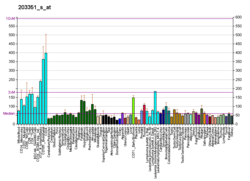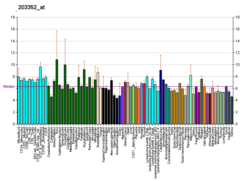Protein-coding gene in the species Homo sapiens
| ORC4 |
|---|
|
| Identifiers |
|---|
| Aliases | ORC4, ORC4L, ORC4P, origin recognition complex subunit 4 |
|---|
| External IDs | OMIM: 603056; MGI: 1347043; HomoloGene: 8059; GeneCards: ORC4; OMA:ORC4 - orthologs |
|---|
| Gene location (Human) |
|---|
 | | Chr. | Chromosome 2 (human)[1] |
|---|
| | Band | 2q23.1 | Start | 147,930,396 bp[1] |
|---|
| End | 148,021,604 bp[1] |
|---|
|
| Gene location (Mouse) |
|---|
 | | Chr. | Chromosome 2 (mouse)[2] |
|---|
| | Band | 2|2 C1.1 | Start | 48,792,836 bp[2] |
|---|
| End | 48,840,289 bp[2] |
|---|
|
| RNA expression pattern |
|---|
| Bgee | | Human | Mouse (ortholog) |
|---|
| Top expressed in | - Achilles tendon
- oocyte
- islet of Langerhans
- ganglionic eminence
- kidney tubule
- bronchial epithelial cell
- corpus callosum
- endothelial cell
- right uterine tube
- right ventricle
|
| | Top expressed in | - otic placode
- saccule
- spermatocyte
- superior frontal gyrus
- thymus
- morula
- neural tube
- secondary oocyte
- medullary collecting duct
- cerebellar cortex
|
| | More reference expression data |
|
|---|
| BioGPS | 
 | | More reference expression data |
|
|---|
|
| Gene ontology |
|---|
| Molecular function | - nucleotide binding
- DNA binding
- DNA replication origin binding
- protein binding
- ATP binding
| | Cellular component | - nuclear origin of replication recognition complex
- nucleolus
- origin recognition complex
- nucleus
- nucleoplasm
- cytosol
| | Biological process | - G1 phase
- DNA replication
- DNA replication initiation
- G1/S transition of mitotic cell cycle
| | Sources:Amigo / QuickGO |
|
| Orthologs |
|---|
| Species | Human | Mouse |
|---|
| Entrez | | |
|---|
| Ensembl | | |
|---|
| UniProt | | |
|---|
| RefSeq (mRNA) | NM_001190879
NM_001190881
NM_001190882
NM_002552
NM_181741
|
|---|
NM_181742
NM_001374270
NM_001374272 |
| |
|---|
NM_001177313
NM_011958
NM_001355296 |
|
|---|
| RefSeq (protein) | NP_001177808
NP_001177810
NP_001177811
NP_002543
NP_859525
|
|---|
NP_859526
NP_001361199
NP_001361201 |
| |
|---|
NP_001170784
NP_036088
NP_001342225 |
|
|---|
| Location (UCSC) | Chr 2: 147.93 – 148.02 Mb | Chr 2: 48.79 – 48.84 Mb |
|---|
| PubMed search | [3] | [4] |
|---|
|
| Wikidata |
| View/Edit Human | View/Edit Mouse |
|
Origin recognition complex subunit 4 is a protein that in humans is encoded by the ORC4 (ORC4L) gene.[5][6][7]
Function
The origin recognition complex (ORC) is a highly conserved six subunit protein complex essential for the initiation of the DNA replication in eukaryotic cells. Studies in yeast demonstrated that ORC binds specifically to origins of replication and serves as a platform for the assembly of additional initiation factors such as Cdc6 and Mcm proteins. The protein encoded by this gene is a subunit of the ORC complex. It has been shown to form a core complex with ORC2L, -3L, and -5L. Three alternatively spliced transcript variants encoding the same protein have been reported.[7]
Interactions
ORC4 has been shown to interact with:
References
- ^ a b c GRCh38: Ensembl release 89: ENSG00000115947 – Ensembl, May 2017
- ^ a b c GRCm38: Ensembl release 89: ENSMUSG00000026761 – Ensembl, May 2017
- ^ "Human PubMed Reference:". National Center for Biotechnology Information, U.S. National Library of Medicine.
- ^ "Mouse PubMed Reference:". National Center for Biotechnology Information, U.S. National Library of Medicine.
- ^ a b Quintana DG, Hou ZH, Thome KC, Hendricks M, Saha P, Dutta A (Nov 1997). "Identification of HsORC4, a member of the human origin of replication recognition complex". The Journal of Biological Chemistry. 272 (45): 28247–51. doi:10.1074/jbc.272.45.28247. PMID 9353276.
- ^ Eki T, Dean FB, Kohda A, Okumura K, Abe M, Murakami Y, Ishiai M, Satomoto K, Hurwitz J, O'Donnell M, Hanaoka F (October 1998). "Assignment of the homologue of the yeast origin recognition complex subunit ORC4 (ORC4L) to human chromosome band 2q22→q23 by in situ hybridization and somatic cell hybrid analysis". Cytogenetics and Cell Genetics. 81 (1): 89–90. doi:10.1159/000014997. PMID 9691185. S2CID 46878915.
- ^ a b "Entrez Gene: ORC4L origin recognition complex, subunit 4-like (yeast)".
- ^ a b c d e f g h Kneissl M, Pütter V, Szalay AA, Grummt F (Mar 2003). "Interaction and assembly of murine pre-replicative complex proteins in yeast and mouse cells". Journal of Molecular Biology. 327 (1): 111–28. doi:10.1016/s0022-2836(03)00079-2. PMID 12614612.
- ^ a b c Dhar SK, Delmolino L, Dutta A (Aug 2001). "Architecture of the human origin recognition complex". The Journal of Biological Chemistry. 276 (31): 29067–71. doi:10.1074/jbc.M103078200. PMID 11395502.
- ^ a b Vashee S, Simancek P, Challberg MD, Kelly TJ (Jul 2001). "Assembly of the human origin recognition complex". The Journal of Biological Chemistry. 276 (28): 26666–73. doi:10.1074/jbc.M102493200. PMID 11323433.
- ^ Pinto S, Quintana DG, Smith P, Mihalek RM, Hou ZH, Boynton S, Jones CJ, Hendricks M, Velinzon K, Wohlschlegel JA, Austin RJ, Lane WS, Tully T, Dutta A (May 1999). "latheo encodes a subunit of the origin recognition complex and disrupts neuronal proliferation and adult olfactory memory when mutant". Neuron. 23 (1): 45–54. doi:10.1016/s0896-6273(00)80752-7. PMID 10402192. S2CID 781511.
- ^ Quintana DG, Thome KC, Hou ZH, Ligon AH, Morton CC, Dutta A (Oct 1998). "ORC5L, a new member of the human origin recognition complex, is deleted in uterine leiomyomas and malignant myeloid diseases". The Journal of Biological Chemistry. 273 (42): 27137–45. doi:10.1074/jbc.273.42.27137. PMID 9765232.
Further reading
- Maruyama K, Sugano S (Jan 1994). "Oligo-capping: a simple method to replace the cap structure of eukaryotic mRNAs with oligoribonucleotides". Gene. 138 (1–2): 171–4. doi:10.1016/0378-1119(94)90802-8. PMID 8125298.
- Suzuki Y, Yoshitomo-Nakagawa K, Maruyama K, Suyama A, Sugano S (Oct 1997). "Construction and characterization of a full length-enriched and a 5'-end-enriched cDNA library". Gene. 200 (1–2): 149–56. doi:10.1016/S0378-1119(97)00411-3. PMID 9373149.
- Tugal T, Zou-Yang XH, Gavin K, Pappin D, Canas B, Kobayashi R, Hunt T, Stillman B (Dec 1998). "The Orc4p and Orc5p subunits of the Xenopus and human origin recognition complex are related to Orc1p and Cdc6p". The Journal of Biological Chemistry. 273 (49): 32421–9. doi:10.1074/jbc.273.49.32421. PMID 9829972.
- Springer J, Kneissl M, Pütter V, Grummt F (Aug 1999). "Identification and characterization of MmORC4 and MmORC5, two subunits of the mouse origin of replication recognition complex". Chromosoma. 108 (4): 243–9. doi:10.1007/s004120050374. PMID 10460412. S2CID 8689588.
- Jiang W, McDonald D, Hope TJ, Hunter T (Oct 1999). "Mammalian Cdc7-Dbf4 protein kinase complex is essential for initiation of DNA replication". The EMBO Journal. 18 (20): 5703–13. doi:10.1093/emboj/18.20.5703. PMC 1171637. PMID 10523313.
- Thome KC, Dhar SK, Quintana DG, Delmolino L, Shahsafaei A, Dutta A (Nov 2000). "Subsets of human origin recognition complex (ORC) subunits are expressed in non-proliferating cells and associate with non-ORC proteins". The Journal of Biological Chemistry. 275 (45): 35233–41. doi:10.1074/jbc.M005765200. PMID 10954718.
- Vashee S, Simancek P, Challberg MD, Kelly TJ (Jul 2001). "Assembly of the human origin recognition complex". The Journal of Biological Chemistry. 276 (28): 26666–73. doi:10.1074/jbc.M102493200. PMID 11323433.
- Dhar SK, Delmolino L, Dutta A (Aug 2001). "Architecture of the human origin recognition complex". The Journal of Biological Chemistry. 276 (31): 29067–71. doi:10.1074/jbc.M103078200. PMID 11395502.
- Okuno Y, McNairn AJ, den Elzen N, Pines J, Gilbert DM (Aug 2001). "Stability, chromatin association and functional activity of mammalian pre-replication complex proteins during the cell cycle". The EMBO Journal. 20 (15): 4263–77. doi:10.1093/emboj/20.15.4263. PMC 149150. PMID 11483529.
- Kneissl M, Pütter V, Szalay AA, Grummt F (Mar 2003). "Interaction and assembly of murine pre-replicative complex proteins in yeast and mouse cells". Journal of Molecular Biology. 327 (1): 111–28. doi:10.1016/S0022-2836(03)00079-2. PMID 12614612.
- Ramachandran N, Hainsworth E, Bhullar B, Eisenstein S, Rosen B, Lau AY, Walter JC, LaBaer J (Jul 2004). "Self-assembling protein microarrays". Science. 305 (5680): 86–90. Bibcode:2004Sci...305...86R. doi:10.1126/science.1097639. PMID 15232106. S2CID 20936301.
- Sibani S, Price GB, Zannis-Hadjopoulos M (May 2005). "Ku80 binds to human replication origins prior to the assembly of the ORC complex". Biochemistry. 44 (21): 7885–96. doi:10.1021/bi047327n. PMID 15910003.
- Rual JF, Venkatesan K, Hao T, Hirozane-Kishikawa T, Dricot A, Li N, Berriz GF, Gibbons FD, Dreze M, Ayivi-Guedehoussou N, Klitgord N, Simon C, Boxem M, Milstein S, Rosenberg J, Goldberg DS, Zhang LV, Wong SL, Franklin G, Li S, Albala JS, Lim J, Fraughton C, Llamosas E, Cevik S, Bex C, Lamesch P, Sikorski RS, Vandenhaute J, Zoghbi HY, Smolyar A, Bosak S, Sequerra R, Doucette-Stamm L, Cusick ME, Hill DE, Roth FP, Vidal M (Oct 2005). "Towards a proteome-scale map of the human protein-protein interaction network". Nature. 437 (7062): 1173–8. Bibcode:2005Natur.437.1173R. doi:10.1038/nature04209. PMID 16189514. S2CID 4427026.


















